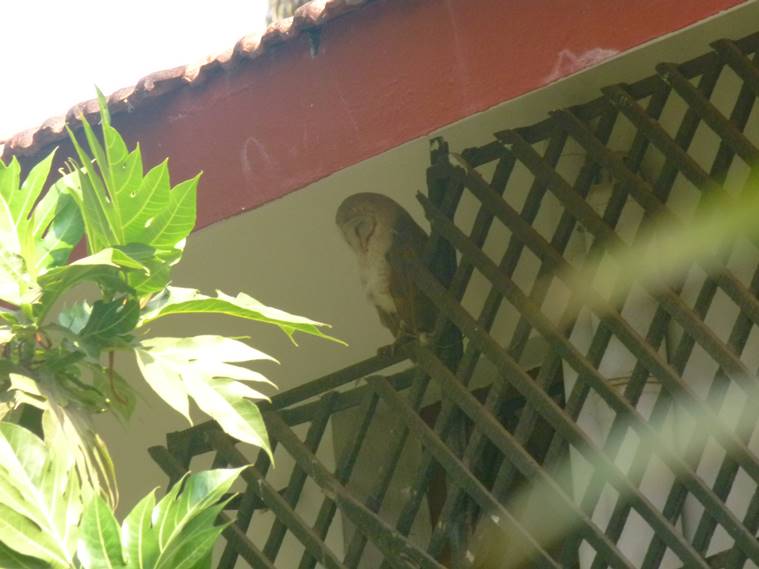Latest Comment
Post Comment
Read Comments
 A greedy koel (Pic source: Ranjit Lal)
A greedy koel (Pic source: Ranjit Lal) “Look, isn’t that an owl sitting there, in that balcony on that screen?” my friend asked me. I looked to where she had pointed at and yes, there it was. A calm-faced barn owl, its eyes closed, meditating deeply under the awning, its heart-shaped head tucked into its chin. There was something zen and serene about the bird – it looked like a hermit meditating in his cave. It remained there all day (we kept checking up on it), occasionally opening its eyes sleepily before dozing off again. The balcony provided a perfect refuge from crows and tree-pies which would have heckled and mobbed it if they had seen it.
“It’ll probably be off hunting tonight,” I said. Which, it might well have done, but next morning to our delight, it was back there, deep in yogic meditation. Just looking at it sort of set the tone for the holiday – serene, relaxed and laid-back. It was gone on the third morning and didn’t return but it couldn’t have given us a better welcome to Goa – where I was glad to be back again after a couple of months. In deference to it, I named it Tyto palmas (Tyto being its generic name and “palmas” after ‘Las Palmas’, the place we stayed at).
As the days went by, yet again, I found that birds, like us, lead a fairly routine life: As the sun came up, a small family of lesser cormorants would fly across, heading south, occasionally followed by a hoarsely croaking black-crowned night heron. On the beanstalk-like coconut tree at the far end of the garden, a pair of black-rumped flamebacks (golden backed woodpeckers) would corkscrew around the trunk, their eyes bright and enquiring, before flying off with a ringing crackle of laughter. They’d turn up again in the evenings, and on one occasion, a singleton clamped itself on the small palm right in front of my balcony, and startled by my proximity, flew off quickly. Devil-tailed drongoes fluted and tossed themselves around every morning; hidden within the depths of the foliage, the shikra’s hunting cry rang out clear and shrill. I spotted it once, flying in fast-fluttering circles high above. Here too, the brahminy kites wheeled easily, their shiny russet suits in wonderful contrast to their linen-white heads and beaks. They looked like they were riding some invisible gentle roller coaster – minus the hullabaloo that usually accompanies these rides.
 The calming barn owl (Pic source: Ranjit Lal)
The calming barn owl (Pic source: Ranjit Lal)
Every evening a quartet of green bee-eaters would skate high up on triangular wings, trilling musically, and both morning and evenings, a honeymooning pair of red-vented bulbuls would cosy up with each other on the very top of a huge mango tree that had just burst into flower. Like rockets, plum-headed parakeets would whistle past, and the harsh calls of the bigger and slower Alexandrine parakeets occasionally accompanying them. Strangely, I never caught a glimpse of the usually more common rose-ringed parakeet – not even on the guava tree in the garden!
I kept a sharp lookout for the resident magpie robin, (who on one occasion had stymied me by pretending to be three different birds by singing three different songs from virtually the same place) and sure enough, there he and his wife were – hopping down diffidently on to the grass from low perches to pick up their breakfast. The gentleman was still practising his melodies, and unlike the earlier occasion, in summer (when recitals began at 5 am), properly rehearsed only around 8 am. The white-throated kingfisher that used to be a regular at the pool for an early morning dip, only visited the water tank on the terrace once: perhaps the pool at this time of the year was too chilly for it! To our delight, one evening (and several thereafter) we heard the harsh “chrr!” of the paradise flycatcher, and caught fleeting glimpses of it, as it dipped into the pool after a day’s work. It was a gentleman, but in russet and white, not yet wearing (perhaps it never would) the all snowy-white suit its species is renowned for. But to compensate, within moments of my arrival, a fully silvery-white gentleman in coat and tails and glistening blue-black head and crest, performed a fluttery ballet like dance-and-dip in the pool of a friend who ran a home-stay nearby. He disappeared into the cool green shade of the surrounding jamun trees before I could unleash my camera, but it was more than enough!
The purple-rumped sunbirds were less obvious this time around, zipping in and out of the heliconia like little bejewelled shooting stars, but there were surprises too: An adolescent peacock that roosted atop the coconut palm and would bluster down every morning after having been driven off by the resident crows. Greedy koels soon discovered that the red palm right outside my bedroom window was laden with delicious yellow-green berries and would crash into the tree clumsily, keeping radio silence while they stuffed their faces to their hearts’ content, giving me an opportunity to eyeball them from maybe just a meter away! They would glare at me out of their disconcerting crimson eyes, their black plumage tinged with bronze-green. Nearly always, it was the gentlemen who turned up. On the one occasion when a lady dared, she was pounced on, courted and mated with and seen off emitting a squawk of outrage.
One regrettable AWOL was the magnificent white-bellied sea-eagle I had spotted twice at the same beach on previous occasions. Two visits on this trip drew blanks, but, then there’s the perfect excuse to go back there again asap!





